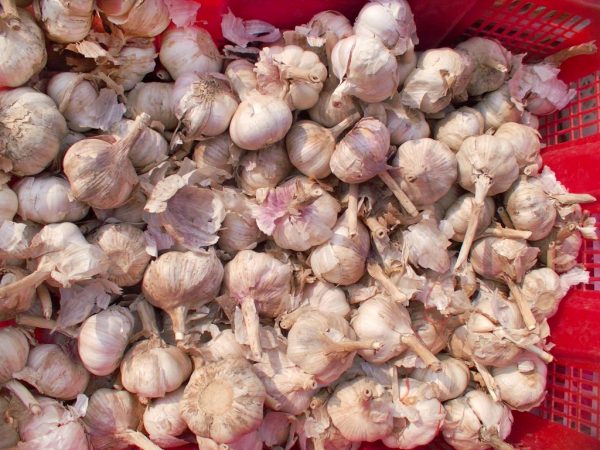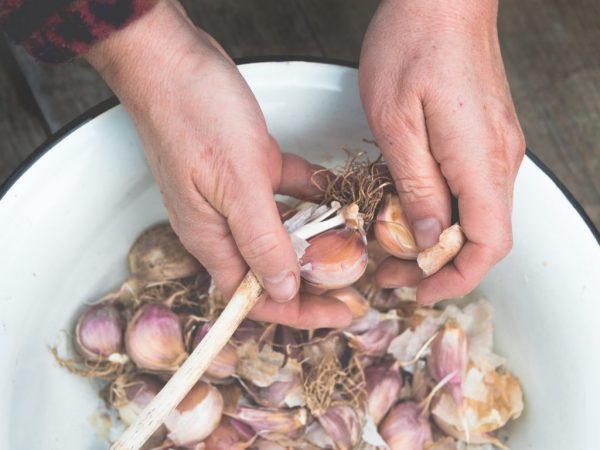Garlic processing technique
Garlic has long been a favorite addition to many dishes. This root vegetable is very popular among farmers due to its spicy taste, unpretentious cultivation and good keeping quality. However, in order to be able to grow a crop planted before winter, proper processing of garlic is needed.

Garlic processing technique
Selection of tubers
The selection of tubers for planting is of great importance. Choose only healthy specimens without visible mechanical damage and rot. Garlic propagates with whole tubers - one-tooth or separate cloves taken from the outside.
Garlic with a multi-colored husk: pink or blue veins is best stored. There should be no cracks on the bottom. In addition, it is important to take into account the peculiarities of your region and select a variety that is zoned, otherwise you will not be able to harvest a good harvest for at least 2 years until the culture adapts to climatic conditions.
A long period of growing the same culture leads to the accumulation of pathological microorganisms in the heads, provoking the development of various diseases, as well as pest larvae. Once every few years, 1/3 of the seed must be changed to one-tooth. This seed is obtained from aerial bulbs.
Processing before planting
Processing garlic before planting with a decontamination solution is a must. Even completely healthy-looking teeth can be infected with bacteria or pest larvae. For processing use:
- ash solution;
- manganese.
The ash solution helps not only to disinfect the tubers, but also to enrich them with nitrogen, which is necessary for normal plant growth in the future. It is prepared at the rate of 400 g of wood ash per 2 liters of liquid. The solution is boiled for 30 minutes and cooled. Then the teeth are immersed in it for 2 hours.
The manganese solution is made slightly pink. Put 1 tsp on 10 liters of water. The garlic is immersed in the solution for 10 hours. The same seedbed preparation method is used for onions. For disinfection, you can use hydrogen peroxide.
Fitosporin treatment
If traces of a fungal disease were found on at least one tuber, it must be destroyed immediately, and it is imperative to treat the entire seed with the antifungal drug Fitosporin. The advantages of this tool are that it can be used at any stage of plant development.
After processing the garlic, before sowing, you still need to pour the solution into the beds. Preventive treatment is carried out every 14 days after the appearance of the first shoots. You need to dilute the solution 1-2 hours before the procedure.
Copper sulfate treatment
One of the universal disinfectants is copper sulfate. Its 1% solution is most often used to disinfect garlic tubers. Garlic cloves are processed in 2 stages:
- keep the seed in saline for 2 minutes;
- soaking for 30 minutes in a solution of copper sulfate.
Plants can be treated with copper sulfate after the first shoots appear to prevent fungal diseases. Put 1 tsp on 10 liters of water. copper sulfate and 1 tbsp. l. laundry soap, grated. Onions are processed in the same way.
Disease treatment

Garlic should be processed before planting.
Despite the fact that garlic is considered a disease resistant crop, it can sometimes be affected by certain pests and fungi. Most often, this happens due to:
- improper care;
- non-compliance with the rules of crop rotation.
Weakened plants can be exposed to more than one virus, but several at once. Before planting, the teeth must be disinfected in warm water with the addition of 5 drops of hydrogen peroxide for 15 minutes.
Downy mildew
In wet weather, fungal spores actively reproduce. Perosporonosis makes the leaves brittle, lighter areas appear on them. For prevention and treatment use:
- phytosporin;
- Bordeaux liquid
- copper sulfate.
Pre-sowing treatment of the cloves by calcining them in the oven is an excellent prevention. Hot water treatment 50 ℃ can be used instead of calcining. The seed is immersed in the liquid for literally 15 minutes, then cooled in cold water and dried.
Rust and neck rot
These diseases very often affect onions and garlic. Rust appears as yellowish streaks on the leaves. Over time, they darken and cause the deciduous part of the plant to dry out. Neck rot infects tubers during storage. The vegetables become soft and smell bad.
In order to prevent and treat diseases, only completely dry, healthy roots should be left for storage. Of the drugs used:
- phytosporin-M;
- Bordeaux liquid;
- copper oxychloride solution 1%.
Stem nematode
The pest sucks sap from plants. Damaged plants begin to turn yellow and eventually dry out completely. The root crop becomes soft, loose, and acquires an unpleasant odor. The bottom becomes rotten.
Prevention and treatment measures:
- compliance with crop rotation;
- disinfection of seed before planting;
- regular inter-row weeding;
- treatment of the holes with the preparation Stormbreaker.
Onion hoverfly
The larvae infect the heads of root crops and destroy them. Ultimately, the tuber rots and takes on an unpleasant odor. As a preventive measure and treatment, the rules of crop rotation should be observed. Garlic should not be planted in areas close to the site of last year's infestation. The aisles need to be mulched with peat and sand.
If egg clutches are found, plantings should be treated with ash and lime, in a 1: 1 ratio. The plantings need to be processed several times over 4 weeks. Spoiled plants should be removed and burned immediately to prevent the spread of pests.
Weed control

Weed control using various methods
Herbicides
Weeds very often provoke the appearance of fungal diseases and pests. Sometimes weeds are very difficult to handle by hand. A separate group of drugs called herbicides is intended for this. They effectively destroy the roots of weeds without affecting the crop itself. For processing winter garlic, the following preparations are often used: Lontrel Grand, Stomp, Targa Super.
Spraying rules
The action of such drugs can be directed only to weeds or to all plants. It is worth carefully reading the instructions before using the funds in order to properly carry out all the procedures and not be left without a crop. Spraying should be carried out when the plants already have 2 leaves or in the fall before sowing. These products effectively remove weeds and some pests.It is important to remember that after using herbicidal products, you will need to take care of the timely introduction of fertilizing.
Lontrel Grand is used to remove annual and perennial weeds. If garlic is grown on green feathers, then its use is contraindicated. Processing is carried out when the weeds reach 15-20 cm in height. The optimum air temperature for procedures is 10 - 25 ℃.
The stomp is used to kill annual weeds.
Processing is carried out on wet soil. The planted garlic should be in the soil at a depth of at least 5 cm. The action of the herbicide lasts for 3-4 months.
Targa Super is used for effective destruction of annual weeds. After etching, the beds should not be weeded for 1.5 months. When using the above remedies, garlic should not be eaten for a month.
Fungicides
Fungicides are divided into:
- organic;
- inorganic (pesticides).
Garlic is treated with pesticides to get rid of plantings from infectious and other types of diseases, to destroy weeds and pests. These are chemicals that can heal plants in a short time. If possible, of course, it is better to try to do without them, since pesticides tend to accumulate in tubers. Among the most powerful drugs are noted: Galigan, Gezagard, Goal.
Among organic fungicidal agents, many farmers note the drug Maxim. It is designed to protect tubers from rot during storage and before planting. The use of a fungicidal agent in the pre-planting period allows you to create a barrier in the rhizome zone, which remains throughout the season. In addition to the protective function, it stimulates active plant growth.
Final part
An important point in obtaining a good harvest of garlic is the timely processing of seeds and soil from all kinds of bacteria. The disinfection procedure should not be neglected, because spores of fungi and pest larvae can persist inside the cloves for a long time, while the root crop will remain healthy. In addition, additional processing of winter garlic helps to keep the cloves intact in the soil throughout the winter.
For prevention purposes, it is important to follow the rules of crop rotation. You should not plant a crop for several years in a row in one place. Garlic responds well to the introduction of additional fertilizers into the soil. The introduction of chicken manure or manure is carried out under the previous crop, it is an excellent prevention of the appearance of some pests.


